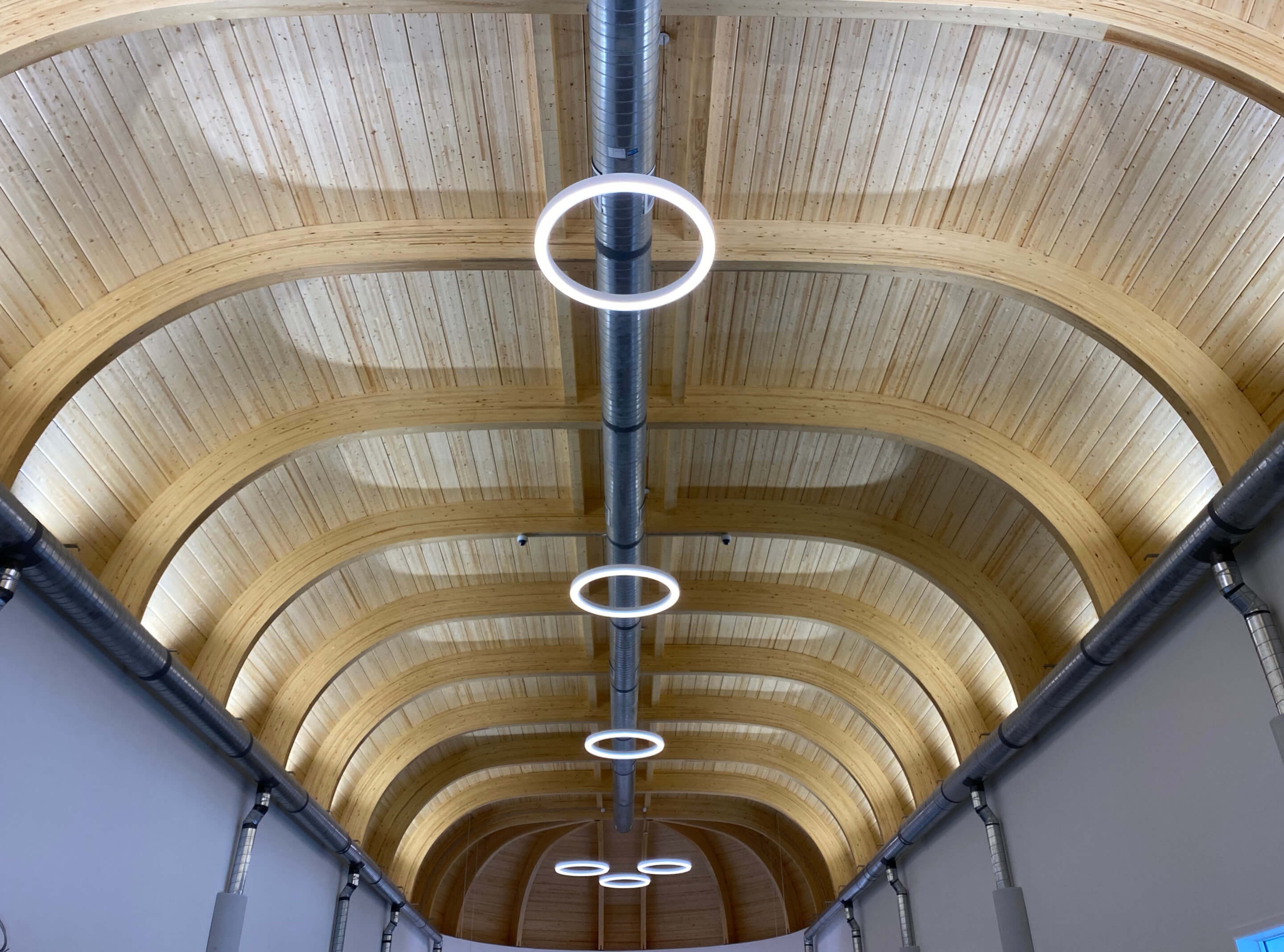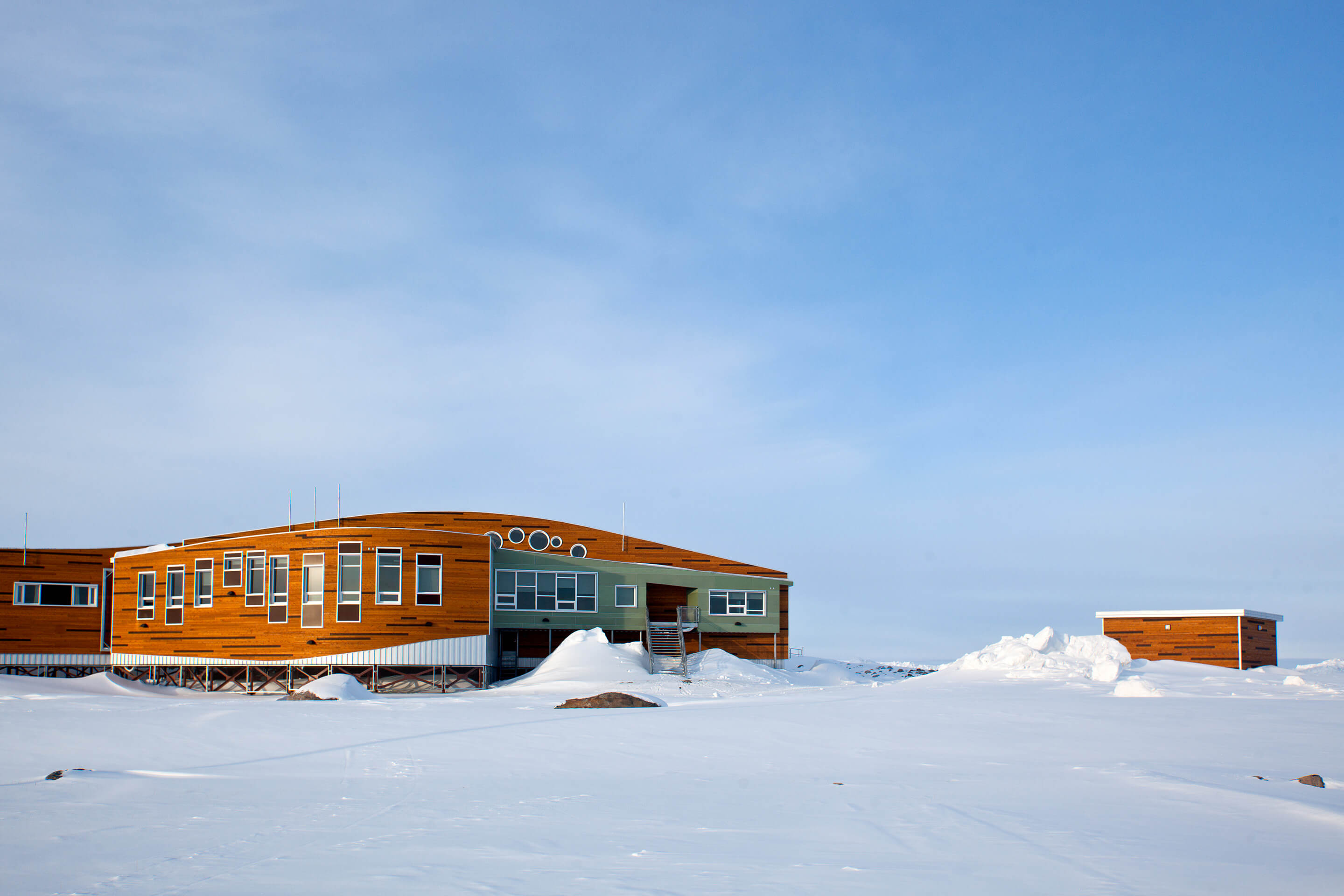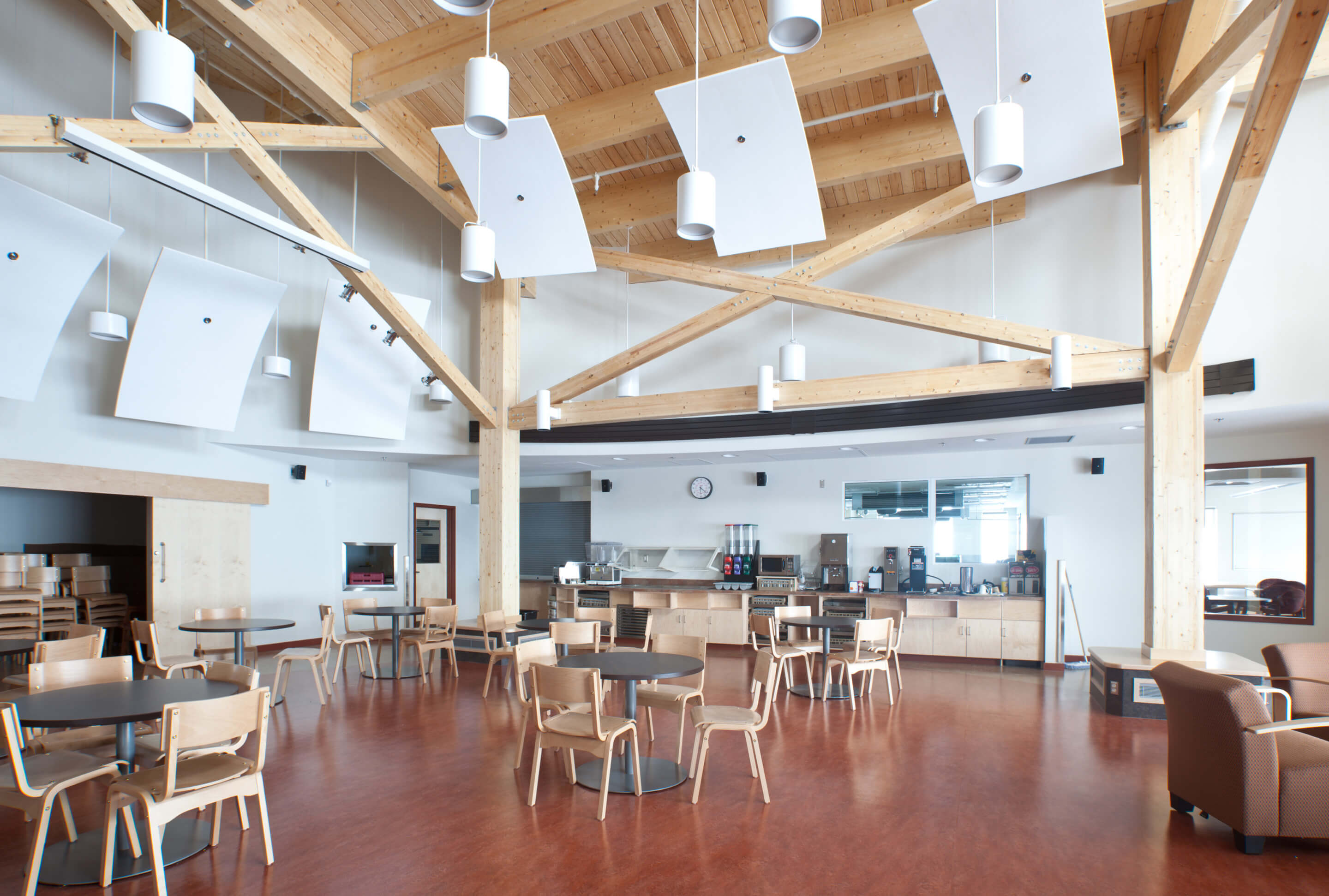The rising popularity of mass timber products in Canada and the United States has led to a rediscovery of fundamentals among architects. Not least Indigenous architects, for whom engineered wood offers a pathway to recover and advance the building traditions of their ancestors. Because timber is both a natural, renewable resource and a source of forestry jobs, it aligns with Indigenous values of stewardship and community long obscured by the 20th century’s dominant construction practices.
For Brian Porter, principal of Two Row Architect in Ohsweken, Ontario, mass timber compels architects to relearn the art of making the most out of natural materials. “Where I come from, Six Nations of the Grand River, where we were longhouse people,” Porter said, “most of the longhouses are made out of, maximum, four- or six-inch-diameter wood poles that were bent to form structural arches.” By post-tensioning the poles, these erstwhile builders were modifying the material to take maximum advantage of its inherent strength. Cross-laminated timber (CLT), glulam, and related products update this approach, Porter suggests, because they make use of “not-so-precious, softwood species that grow quickly, putting them together in columns and two-dimensional planes.” The radial glulam structure of the Council Chamber in the Seneca Nation’s Allegany Administration Building in Salamanca, New York, exemplifies Two Row’s fusion of culturally respectful forms and new interpretations of old materials. (The project was completed in 2010 with Buffalo’s Kideney Architects.)

Timber had already achieved a “mass” status in Austria and Germany by the early 1990s, but it had yet to take root in North America. And where it had, the material was not being deployed in accord with the principles of Indigenous peoples, who belong to Inuit or Métis nations, or to First Nation “bands.” The first building to do that, according to Porter, was a small school for the Stó:lō (Lower Fraser River Salish or Séliš) people living on the Seabird Island Band, a couple of hours’ drive east of Vancouver. Designed by Patkau Architects and opened in 1990, the project used Weyerhaeuser Parallam parallel-strand beams, oriented strand board, and cedar shingles in what Porter calls “a modern-day interpretation not only of the plank house but also of the surrounding landscape.”
Both conceptually sensitive and spatially generous, the Seabird Island School, however, continues to be an exception to the type of construction performed for Canada’s Indigenous peoples, typified by generic, cost-cutting design and cultural inattention. Douglas Cardinal, an elder statesman among Indigenous architects, has in his lengthy career seen flashes of promise overtaken again and again by the forces of convention. He laments the clear-cutting of forests and lambastes the impoverished building script of the 20th century that plays out in Indigenous communities. “You have suburbs that are all filled with stick-built houses and drywall, that are really blowing energy out of their walls and windows,” Cardinal said. “The true architects of our housing are not architects—they’re developers that are trying to do things as cheap and nasty as they possibly can.”
He has found mass timber useful in numerous projects, particularly the Oujé-Bougoumou Cree Nation village southeast of James Bay in northern Quebec, which won the United Nations “We the Peoples” Award, the Habitat II: Best Practices Award, and the Canada Mortgage and Housing Award. A return to natural materials, he contends, improves durability, resistance to mold and fire, aesthetics, and energy efficiency. This performative aspect of Indigenous building know-how deserves the same level of appreciation given to its cultural aspects, argues Harriet Burdett-Moulton. A former senior architect at Stantec who comes from a Labrador Métis background, Burdett-Moulton founded the eastern Arctic’s first architecture firm and has designed over 200 buildings in Nunavut, Canada’s northernmost territory. She recalled how the Arctic regions where she has worked are rough on materials, which need to be “shipped in from faraway sources, often only once a year.” If something breaks or warps en route, it isn’t replaced, and those materials more resistant to damage—primarily steel and concrete—are heavy and thus prohibitively expensive to ship. Besides, the cold temperatures make concrete difficult to work with, Burdett-Moulton added.
Wood, on the other hand, is replenishable, easy to work, and adaptable, as is CLT, which, she has observed, handles low-humidity conditions better than untreated wood. “Moisture content in wood that is acceptable in southern Canada will warp and crack after it arrives on-site in places like Igloolik, Pangnirtung, or Qikiqtarjuaq,” she said.

But mass timber’s material benefits aren’t enough to rectify poor construction standards, which often suffer when outside builders lack accountability to local residents. According to Burdett-Moulton, suppliers hundreds of miles away commonly shortchange remote communities by sending the lowest-quality products, knowing return shipment is costly. Even well-intentioned efforts by the Canadian government requiring that building projects within nations or bands bear input from Indigenous consultants have failed to make an impact, she said. “[T]he people who are selected as consultants often do not understand what is being asked of them. Very little thought has gone into training or explaining to the local people what a particular project is about, or the type of information that would be useful to the designers.”

Burdett-Moulton notes that Indigenous communities have housing shortages that expanded use of timber could remedy, were it not for procedural hindrances. Porter echoes her complaint and points to building codes and insurance policies that effectively preclude the use of uncertified materials—namely, locally cut and milled lumber—even in instances where it is fiscally and environmentally beneficial. In particular, First Nations bands, he said, “are surrounded by these timber forests, but because all of their funding agreements restrict them to using graded wood, they’re surrounded by these resources that they can’t use. They’re precluded by bureaucracy from incorporating locally harvested timber into their housing solutions.”
Instead, cheap houses vulnerable to mold have been posited as quick fixes. Finding these inadequate, Cardinal developed a modular prototype that is scalable and also durable, thanks to its mass timber structure. Unveiled in 2019 at the Elsipogtog First Nation in New Brunswick, the Cardinal House uses prefabricated CLT panels to speed up construction (after off-site manufacture of weather-tight panels in a controlled environment, on-site assembly took all of three days) and improve on both quality and costs. An earlier CLT project Cardinal designed in northern Quebec for the Algonquins helped to relieve a local seasonal job shortage. Construction on the Long Point School in Winneway was so swift and efficient that laborers did not need to break for midwinter, which, in this frigid clime, typically puts building projects on hold for a couple of months.
Paradoxically, just as interest in Indigenous building practices is at its highest, Cardinal looks to northern Europe for strategies for scaling up mass timber in and around Indigenous nations and bands. His studies of German and Norwegian building methods and forestry convinced him that Canada, with its vast forests, should do the same. “Downtown Bergen, Norway, is all heavy timber construction, and that was designed in the Middle Ages, and it’s still functioning,” Cardinal said. Within North America, he sees the Pacific Northwest adopting mass timber methods fastest, though he hopes for an influential proof of concept in a cultural center that rests on Lenape land: “I think a good wood building in New York would be a real advantage to the industry.”

There are plenty of roadblocks that would stem timber’s rise, however. Misconceptions about fire resistance, for example, are not easily assuaged. Trade organizations are pivotal in dislodging such attitudes; among these, the Toronto-based Mass Timber Institute (MTI) has been the most active, educating AEC practitioners on timber’s environmental and economic impact. (Editor’s note: The MTI has partnered with The Architect’s Newspaper on the institute’s two-part TimberCon virtual event series; the first installment occurred in March, with the follow-up set for October.) Porter hails that outreach, just as he salutes regional efforts like the Whitefeather Forest Initiative north of Red Lake in Ontario. The initiative lists the Pikangikum First Nation as equity partners in a sustainable forest and, as such, offers educational programming for Indigenous students to study ecosystem management.
Yet, Indigenous architecture remains “a work in progress,” Burdett-Moulton said. “There are architects with Indigenous roots that are closer to the land and [to] Indigenous values than their sister and brother architects,” she said—in other words, the Indigenous experience was never homogeneous, nor is it today. Even so, Porter is optimistic about the cumulative effect of this knowledge sharing. “Mainstream architecture,” he said, “is coming closer and closer to the Indigenous worldview that we’ve had for 30,000 years.”










